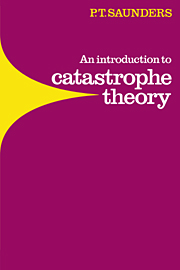Book contents
- Frontmatter
- Contents
- Preface
- 1 Introduction
- 2 Background
- 3 The seven elementary catastrophes
- 4 The geometry of the seven elementary catastrophes
- 5 Applications in physics
- 6 Applications in the social sciences
- 7 Applications in biology
- 8 Morphogenesis
- 9 Conclusions
- Exercises
- Appendix. Elementary catastrophes of codimension ≦ 5
- References
- Author index
- Subject index
5 - Applications in physics
Published online by Cambridge University Press: 05 June 2012
- Frontmatter
- Contents
- Preface
- 1 Introduction
- 2 Background
- 3 The seven elementary catastrophes
- 4 The geometry of the seven elementary catastrophes
- 5 Applications in physics
- 6 Applications in the social sciences
- 7 Applications in biology
- 8 Morphogenesis
- 9 Conclusions
- Exercises
- Appendix. Elementary catastrophes of codimension ≦ 5
- References
- Author index
- Subject index
Summary
An important feature of catastrophe theory is that it can be used not only in many different problems, but also in many different ways. In an essay entitled ‘The two-fold way of catastrophe theory’, Thorn (1976) has characterized the two ends of the spectrum of the theory's applications as the ‘physical’ and the ‘metaphysical’:
Either, starting from known scientific laws (from Mechanics or Physics) you insert the catastrophe theory formalism (eventually modified) as a result of these laws: this is the physical way. Or, starting from a poorly understood experimental morphology, one postulates ‘a priori’ the validity of the catastrophe theory formalism, and one tries to reconstruct the underlying dynamic which generates this morphology: this is the ‘metaphysical’ way. Needless to say, the second way seems to me more promising than the first, if less secure…
It seems natural in a textbook to begin with the more secure examples, and so in this chapter we shall be discussing three applications of catastrophe theory in physics. Because the dynamics are known, almost all the calculations we shall perform will be standard, yet in each case catastrophe theory throws some new light on the problem. In return, these examples contribute to our understanding of catastrophe theory by serving as relatively straightforward illustrations, and also by showing how the range of applicability of the theory extends far beyond systems with gradient dynamics. Caustics For the study of many optical phenomena we may ignore the wave nature of light and consider the energy to be transported along curves known as light rays.
- Type
- Chapter
- Information
- An Introduction to Catastrophe Theory , pp. 61 - 82Publisher: Cambridge University PressPrint publication year: 1980



